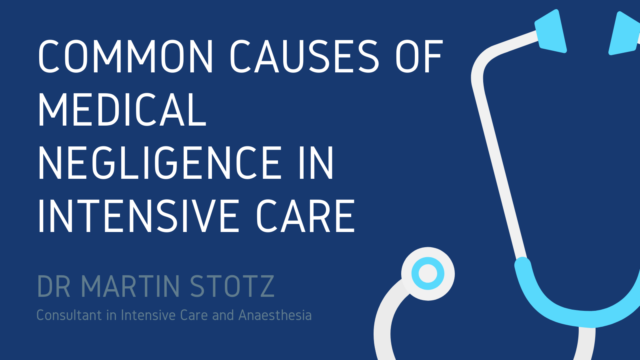The medicolegal implications of catheter-related bloodstream infections

Catheters are used almost universally in the intensive care unit (ICU) and are an essential tool in the care of critically ill patients. They allow the intravenous administration of both medication and fluid resuscitation, along with monitoring of haemodynamic parameters. However, they can also give rise to bloodstream infections, which can result in significant morbidity and mortality, and also carry a significant economic cost. Estimates for the incidence of catheter-related bloodstream infections (CRBSIs) vary considerably, but generally lie in the range of 0.4–4.6 per 1000 catheter-days, and around 35% of these infections prove to be fatal. It is unclear how many CRBSIs could be prevented.
The risk of developing a CRBSI is influenced by many factors, one of which is the site of catheterisation. Central venous catheters may be placed in either the internal jugular, subclavian or femoral vein. The subclavian vein carries the lowest risk of CRBSI, but not all patients may be suitable candidates for this placement site. Blood clotting abnormalities or distortion of anatomical features due to existing pathology may exclude the use of the subclavian vein. Furthermore, this site should be avoided in patients with end stage renal disease, due to the risk of subsequent subclavian stenosis which may complicate access to arteriovenous fistulae. Although femoral catheters have the lowest risk of pneumothorax, they are associated with higher rates of CRBSI, so insertion site should be chosen carefully.
Sterile insertion technique is extremely important in preventing CRBSI. The use of chlorhexidine-impregnated dressings has been shown to reduce both catheter tip pathogen colonisation and subsequent bloodstream infections, compared to standard dressings. When compared to the use of anatomical landmarks to guide the placement of catheters, ultrasound reduces not only mechanical complications but also the number of failed placement attempts. As patients in whom the initial placement attempt was successful have lower rates of complications, including infections, this suggests that, where possible, ultrasound should always be used. In addition, the use of multi-lumen catheters has been shown to lead to an increased number of infections in numerous patient populations. Therefore, the recommended best practice is to use a catheter with the minimum number of lumina essential for effective patient management.
One of the most important factors in the risk of CRBSI is the duration of catheter use. Each day of use increases the risk of colonisation, a precursor to infection. Therefore, it is important that catheters are removed as soon as they are no longer required, and studies have suggested that re-evaluation of catheter use on a daily basis is the optimal strategy for achieving this. Additionally, if there is any suspicion that a CRBSI is developing, the catheter should be removed immediately or exchanged to a new device if necessary. Scheduled catheter replacement does not appear to confer any lower risk of CRBSI compared to replacement on a clinically indicated basis, although exchange methods employing a guidewire are associated with higher rates of colonisation, and infection, compared to replacements at a new site. However, in patients where access is difficult or there is a risk of further long-term complications, replacement using a guidewire remains a possible option.
A further opportunity for contamination and the introduction of infectious agents is provided by catheter manipulation during drug administration. Therefore, preventive measures must be taken to reduce the transmission of potential pathogens. Access ports must be scrubbed with an antiseptic solution, such as chlorhexidine or 70% alcohol for decontamination before use. The optimal length of scrubbing time is not known, but one small study suggested that a scrub duration time of 15 seconds was 20 times more effective than scrubbing for only 3 seconds. This difference in effectiveness demonstrates that human factors may influence the success of decontamination measures. Passive disinfection caps maintain contact between catheter hubs and disinfecting solution without relying on human intervention, and are an effective means of reducing hub colonisation and the risk of CRBSI. Thus, disinfection caps may be an important addition to CRBSI risk reduction programmes.
Recently, several initiatives have been launched with the aim of reducing the incidence of CRBSIs. An intervention programme introduced in ICU units in the US state of Michigan, which combined several of the factors discussed above, successfully reduced the CRBSI infection rate by over 65%, and this reduction was sustained for 18 months of follow-up. The recommended procedures, chosen for having the greatest impact on CRBSI rates but the lowest barriers to implementation, included hand washing, using full-barrier precautions during insertion, using chlorhexidine to clean the skin before insertion, avoiding the femoral site (where possible) and removing unnecessary catheters. However, it was not possible to assess the impact of each of the individual components of the intervention programme in this pragmatic-designed trial.
This study shows that significant reductions in the frequency of CRBSI could be achieved if these simple interventions, which could be achieved without the use of expensive technology or additional members of staff, were successfully introduced globally. This would have a major impact on patient morbidity and mortality. As it would reducing the average length of hospital stay, there would also be a notable economic benefit.
Further reading:
Bell, T., & O’Grady, N. P. (2017). Prevention of Central Line-Associated Bloodstream Infections. Infectious disease clinics of North America, 31(3), 551–559. https://doi.org/10.1016/j.idc.2017.05.007
Pronovost, P., Needham, D., Berenholtz, S., Sinopoli, D., Chu, H., Cosgrove, S., Sexton, B., Hyzy, R., Welsh, R., Roth, G., Bander, J., Kepros, J., & Goeschel, C. (2006). An intervention to decrease catheter-related bloodstream infections in the ICU. The New England journal of medicine, 355(26), 2725–2732. https://doi.org/10.1056/NEJMoa061115




